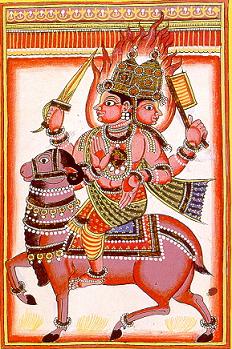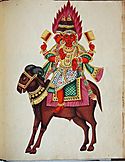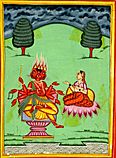Agni facts for kids
Quick facts for kids Agni |
|
|---|---|
| God of Fire | |

Agni upon his mount, with flames leaping upwards from his crown
|
|
| Other names | Mātariśvan |
| Affiliation | Deva, Dikpāla |
| Abode | Agniloka |
| Mantra | Om Agni Vidmahe |
| Weapon | Āgneyāstra |
| Mount | Urial |
| Personal information | |
| Consort | Svāhā |
| Children | Pāvaka, Pāvamāna, Śuchi, Nīla, Agneya |
| Parents | Brahma |
| Equivalents | |
| Greek equivalent | Hephaestus |
| Roman equivalent | Vulcan |
Agni (Sanskrit: अग्नि) is the Hindu god of fire. In the Vedic pantheon, he occupies, after Indra, the most important position.
Agni has three forms, namely fire, lightning, and the Sun. For that reason he is often depicted as having three heads or three legs. He is sometimes shown wearing a garland of fruits or flowers. Agni is typically found in southeast corners of Hindu temples.
Agni is also the natural element fire. Together with sky (Ākāśa), water (Ap), air (Vāyu) and earth (Pṛthvī), it forms all other things (Prakṛti).
As a symbol of fire, Agni is used to refer to fire in the stomach, the cooking fire in a home, the sacrificial fire in an altar, the fire of cremation, and the fire of rebirth, among others.
The Hindus believe that there are three kinds of Agni inside every human being, the krodha-agni or "fire of anger", the kama-agni or "fire of passion and desire", and the udara-agni or "fire of digestion".
Contents
Origin

The earliest Vedic texts state that the universe began with nothing, neither night nor day existed, what existed was just Prajāpati (also referred to as Brahman). Agni originated from the forehead of Prajāpati. With the creation of Agni came light, and with that were created day and night. Agni is the same as the Brahman, the eye of the manifested universe.
Agni was one of the three major gods. His twin brother Indra ruled the atmosphere as the god of storm, rain and war, Sūrya ruled the sky and heavens, and Agni ruled the earth.
Wife and children
The goddess Svāhā is Agni's wife. Her name is pronounced with offerings such as butter and seeds poured into the fire during ceremonies. Agni and Svāhā had a son, Skanda – the god of war.
Ancient medicine and food
Agni was Agni was viewed as the life force in a healthy body, the power to digest foods, and innate in food. In Ayurveda, the amount of Agni determines the state of health.
Agni is an important entity in Ayurveda. It was mentioned in Hindu texts of ancient medicine. There, Agni is the fire needed to digest food and rid the body of waste and toxins. It also helps to transform physical matter into energy the body needs.
Iconography
The depiction of Agni varies by region. He is usually shown with one to three heads and two to four arms. He is often depicted standing next to or riding a ram, with a characteristic dramatic halo of flames leaping upwards from his crown. He is shown as a strong looking man, sometimes bearded, with a large belly because he eats everything offered into his flames, with golden brown hair, eyes and mustache to match the color of fire.
Agni holds a rosary in one hand to symbolize his prayer-related role, and a sphere in another hand in eastern states of India. In other regions, his four arms hold an ax, torch, spoon (or fan) and a flaming spear (or rosary).
Significance
Vedic rituals involve Agni. He is a part of many Hindu rites-of-passage ceremonies such as celebrating a birth (lighting a lamp), prayers (aarti lamp), at weddings (the yajna where the bride and groom circle the fire seven times) and at death (cremation). According to Atharvaveda, it is Agni that conveys the soul of the dead from the pyre to be reborn in the next world or life.
Images for kids
-
Agni is a part of the ritual grammar in many Hindu festivals. Above Holika for Holi, includes Agni.
-
Agni (right) with his son Skanda (Karttikeya), about 1st-century CE.
-
The Buddhist Fire God "Katen" (火天) in Japanese art. Dated 1127 CE, Kyoto National Museum.
See also
 In Spanish: Agni para niños
In Spanish: Agni para niños











